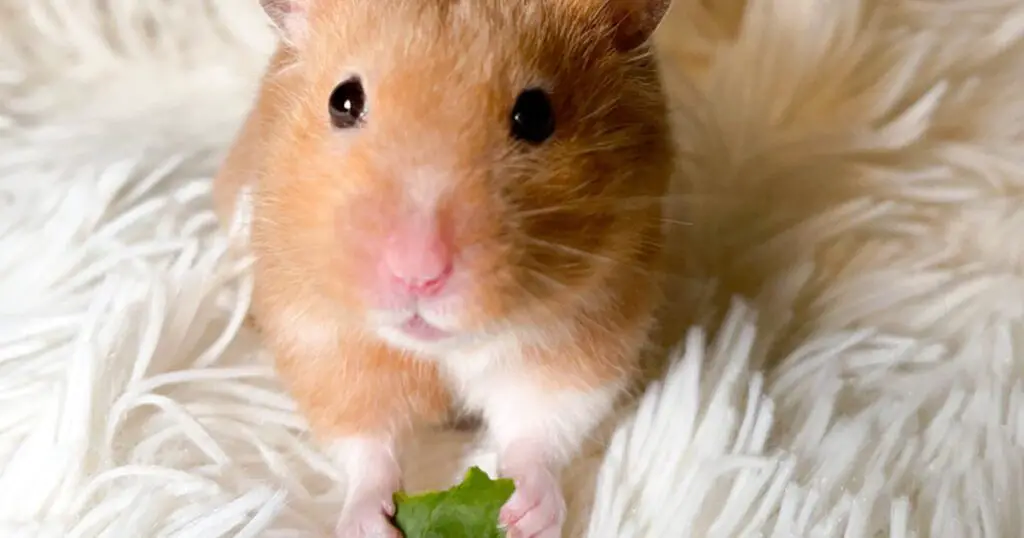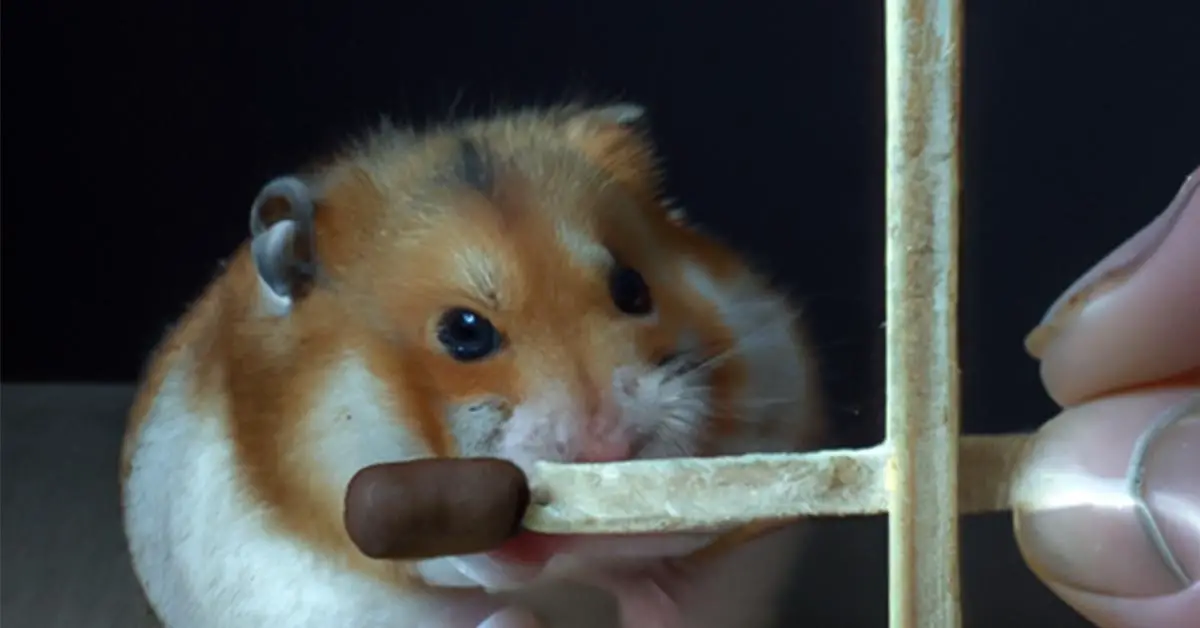Hamsters are small and cute creatures that make great pets. They are easy to take care of and are very low maintenance. One question that often comes up when considering getting a hamster as a pet is: “How big do hamsters get?” The answer to this question varies depending on the type of hamster, as well as other factors such as genetics, diet, and environment. In this article, we will discuss the different types of hamsters and their average sizes, as well as the factors that can affect a hamster’s size.
Table of Contents
Type of Hamsters and Size
Syrian
There are several types of hamsters that are commonly kept as pets, each with their own unique size. The Syrian hamster, also known as the golden hamster, is the most popular pet hamster and is the largest of the pet hamster species. These hamsters typically grow to be around 7-8 inches long and weigh around 4-5 ounces. They have a thick and fluffy coat, which makes them look even bigger. Syrian hamsters are also known for their playful and curious nature, which makes them great companions.

Dwarf
The Dwarf hamster, which includes the Campbell’s Dwarf, Winter White Dwarf, and the Chinese Dwarf, are smaller in size compared to Syrian hamsters. Dwarf hamsters typically grow to be around 4-5 inches long and weigh around 1-2 ounces. They have a sleek and short coat, which makes them look smaller than Syrian hamsters. Dwarf hamsters are also known for their energetic and active nature, which makes them great pets for children.
Roborovski
The Roborovski hamster is the smallest of the common pet hamster species. These hamsters typically grow to be around 2-3 inches long and weigh around 0.5-1 ounce. They have a small and slender body, which makes them look even smaller than Dwarf hamsters. Roborovski hamsters are also known for their friendly and social nature, which makes them great pets for people who like to interact with their pets.
How Big Do Hamsters Get?: Factors Affecting Size
Genetics
There are several factors that can affect a hamster’s size, including genetics, diet, and environment. Genetics plays a big role in determining a hamster’s size, as certain hamster breeds are naturally larger or smaller than others. For example, Syrian hamsters are naturally larger than Dwarf hamsters and Roborovski hamsters.
Diet
A hamster’s diet can also affect its size, as a well-balanced diet can help a hamster reach its full potential size. Hamsters require a diet that is high in protein, carbohydrates, and fats. Feeding your hamster a diet that is low in protein or carbs will result in a hamster that is smaller than it should be. Feeding your hamster a diet that is high in protein or carbs will result in a hamster that is larger than it should be. Feeding your hamster a diet that is high in fats will result in the hamster that is overweight.
Click here for advice from a vet about feeding your hamster.
Hamsters, like all animals, require a balanced diet in order to maintain good health and reach their full potential size. However, there are different nutritional needs and recommended diets for different types of hamsters. In this article, we will discuss the specific dietary needs for Syrian, Dwarf, and Roborovski hamsters.
Syrian Diet
Syrian Hamsters: Syrian hamsters require a diet that is high in protein, carbohydrates, and fats. A diet that is low in protein or carbohydrates can result in a hamster that is smaller than it should be. A diet that is high in fats can result in a hamster that is overweight. A good diet for a Syrian hamster should include a high-quality commercial hamster food, fresh fruits and vegetables, and occasional lean protein such as boiled chicken or boiled egg.
Dwarf Diet
Dwarf Hamsters: Dwarf hamsters have similar dietary needs as Syrian hamsters, requiring a diet that is high in protein, carbohydrates, and fats. However, Dwarf hamsters have a higher metabolism than Syrian hamsters, so they may require more protein and carbohydrates in their diet. A diet that is low in protein or carbohydrates can result in a dwarf hamster that is smaller than it should be. A diet that is high in fats can result in a dwarf hamster that is overweight. A good diet for a Dwarf hamster should include a high-quality commercial hamster food, fresh fruits and vegetables, and occasional lean protein such as boiled chicken or boiled egg.
Roborovski Diet
Roborovski Hamsters: The Roborovski hamster has a higher metabolism than Syrian and Dwarf hamsters and their diet should be high in protein and carbohydrates. They can also benefit from a small amount of healthy fats. A diet that is low in protein or carbohydrates can result in a Roborovski hamster that is smaller than it should be. A diet that is high in fats can result in a Roborovski hamster that is overweight. A good diet for a Roborovski hamster should include a high-quality commercial hamster food, fresh fruits and vegetables, and occasional lean protein such as boiled chicken or boiled egg.
It’s important to note that, as with any animal, it’s important to monitor your hamster’s diet and weight to ensure they are healthy. An overweight hamster may have an increased risk of health problems such as diabetes, while an underweight hamster may have a decreased immune system, making them more susceptible to illnesses. Additionally, it’s important to provide fresh water to your hamster at all times and avoid giving them foods that are high in sugar or salt.
Environment
The environment in which a hamster is kept can also play a role in its size. A hamster that is kept in a clean and healthy environment will be more likely to reach its full size potential. A hamster that is kept in a dirty or unhealthy environment will be more likely to be smaller than it should be.

Size Comparison
To give a visual representation of a hamster’s size, they can be compared to common household items. A Syrian hamster, for example, is roughly the size of a matchstick, while a Dwarf hamster is about the size of a golf ball. A Roborovski hamster, on the other hand, is about the size of a large marble. It is important to keep in mind that these are rough comparisons and actual sizes may vary. It’s also worth noting that size is not the only factor when choosing the right hamster for you, as each species has their own unique characteristics and personalities.
Considerations As A Pet
When considering getting a hamster as a pet, it is important to research the different types of hamsters and their sizes to make sure you are prepared for the size of the pet you will be bringing home. It is also important to consider the space you have available for your hamster and make sure it is suitable for the size of the hamster you are getting. For example, a Syrian hamster will require a larger cage than a Roborovski hamster.
Lifespan
Another important consideration is the lifespan of the hamster. Syrian hamsters have a lifespan of 2-3 years, while Dwarf hamsters and Roborovski hamsters have a lifespan of 2-4 years. This is something to keep in mind if you’re not ready for a long-term commitment or if you have small children who may not be able to understand the concept of losing a pet.
Conclusion
In conclusion, the size of a hamster can vary depending on the type of hamster and other factors such as genetics, diet, and environment. Syrian hamsters are the largest of the pet hamster species, growing to be around 7-8 inches long and weighing around 4-5 ounces. Dwarf hamsters are smaller, growing to be around 4-5 inches long and weighing around 1-2 ounces. The Roborovski hamster is the smallest of the common pet hamster species, growing to be around 2-3 inches long and weighing around 0.5-1 ounce. When considering getting a hamster as a pet, it is important to research the different types of hamsters and their sizes, as well as consider the space and lifespan that you have available for your new pet.
Frequently Asked Questions
Q: What are the different types of hamsters and their average sizes?
A: The Syrian hamster, also known as the golden hamster, is the most popular pet hamster and is the largest of the pet hamster species. These hamsters typically grow to be around 7-8 inches long and weigh around 4-5 ounces. Dwarf hamsters, which includes the Campbell’s Dwarf, Winter White Dwarf and the Chinese Dwarf, are smaller in size compared to Syrian hamsters, typically growing to be around 4-5 inches long and weighing around 1-2 ounces. The Roborovski hamster is the smallest of the common pet hamster species, growing to be around 2-3 inches long and weighing around 0.5-1 ounce.
Q: What are the factors that can affect a hamster’s size?
A: Genetics plays a big role in determining a hamster’s size, as certain hamster breeds are naturally larger or smaller than others. A hamster’s diet can also affect its size, as a well-balanced diet can help a hamster reach its full potential size. The environment in which a hamster is kept can also play a role in its size, as a hamster that is kept in a clean and healthy environment will be more likely to reach its full size potential.
Q: How can I compare the size of different types of hamsters?
A: To give a visual representation of a hamster’s size, they can be compared to common household items. A Syrian hamster, for example, is roughly the size of a matchstick, while a Dwarf hamster is about the size of a golf ball. A Roborovski hamster, on the other hand, is about the size of a large marble. It is important to keep in mind that these are rough comparisons and actual sizes may vary.
Q: What should I consider when getting a hamster as a pet?
A: When considering getting a hamster as a pet, it is important to research the different types of hamsters and their sizes to make sure you are prepared for the size of the pet you will be bringing home. It is also important to consider the space you have available for your hamster and make sure it is suitable for the size of the hamster you are getting, as well as the lifespan of the hamster.
Q: What is the lifespan of a hamster?
A: Syrian hamsters have a lifespan of 2-3 years, while Dwarf hamsters and Roborovski hamsters have a lifespan of 2-4 years.

